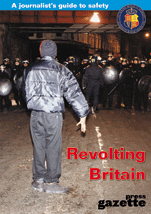A guide to Journalism Safety from Chartered Institute of Journalists
Are you facing intimidation, harassment, and receiving threats to your personal safety (physical and mental health)? Consider your legal rights and the protection you are entitled to from the police and other agencies.
There are many guides available to journalists, which have been put together by organisations and experts with many years’ experience in the industry. These guides are free and available online. We have collated links to some of those guides here, and offer advice to make sure you keep yourself as safe as possible while carrying out your vital work as a journalist.
The Chartered Institute of Journalists sends our very best wishes, profound respects and admiration to all professional journalists covering war, conflict and any dangerous situation.
We implore you to stay safe and well, and thank you for courageously seeking to report the truth in such difficult circumstances.
Covering a news event/story with risks to personal safety
Hazardous work environment risk assessment
If you are being commissioned or assigned to cover a news event/story with risks to personal safety, at the very least, your employing organisation needs to carry out a hazardous work environment risk assessment.
Also, before sending any journalist into a hostile or hazardous environment your commissioning/employing organisation should provide you with special training.
Persuade your employer to provide you with hazardous and hostile environment training.
Insurance
Insurance is very important, and your commissioning/employing organisation needs to properly insure you against the risks you face. This is so that you are guaranteed medical evacuation and specialist protection and effective extraction remedies, and you and your family are financially covered for any injuries and other consequences arising from your work.
Protective equipment
Where there is a likely risk to physical safety in conflict zones, journalists need to be equipped with protective equipment, including body armour, and this is the responsibility of your commissioning and employing publishers.
Reporters Without Borders (RSF) lends bulletproof vests and helmets to freelance journalists travelling to dangerous areas. https://rsf.org/en/borrowing-bulletproof-vests-and-helmets
Health & Wellbeing
It is also recommended that all professional journalists covering distressing events and situations; particularly on a day to day reporting beat, take great care of their mental health.
Get yourself up-to-date First Aid Trained.
Trust your instinct
At the very least trust your instinct and experience. For example, when interviewing strangers for any assignment on a one to one basis, it is recommended that you meet in a public place. Always establish time frames and contact points so that editors/producers and their reporters maintain contact before and after assignment.
The profession of journalism and the experience of its practitioners informs us that we have to be on guard at all times and the risks we face are changing and increasing.
Journalists’ safety guides
The UK Media Lawyers’ Association produced a guide in 2021 which is available online. “Combatting Online Harassment and Abuse: A Legal Guide for Journalists in England and Wales”. This guide draws upon the experience of Caoilfhionn Gallagher QC having advised and assisted journalists dealing with online harassment and fearing for their safety.’ https://medialawyersassociation.files.wordpress.com/2021/06/combatting-online-harassment-and-abuse-23.06.2021-09.10-5.pdf
Revolting Britain: a safety guide for journalists
The Institute produced a journalism safety guide in 2006 to introduce you to basic advice and guidance.
The NGO, Reporters Without Borders, has a longstanding online ‘Safety Guide for Journalists’, 144 pages, endorsed by UNESCO and last updated 2015. https://rsf.org/sites/default/files/2015-rsf-safety-guide-for-journalists.pdf
The US charity Committee to Protect Journalists provides the following online resources
- War Reporting https://cpj.org/2019/10/physical-safety-war-reporting/
- Arrest and Detention https://cpj.org/2021/02/physical-and-digital-safety-arrest-and-detention/
- Civil Disorder https://cpj.org/2018/09/physical-safety-civil-disorder/
- Internet Shutdowns https://cpj.org/2021/04/digital-safety-internet-shutdowns/
- Digital Safety- Working from Home: https://cpj.org/2020/04/digital-safety-working-from-home/
- CPJ Safety Kit https://cpj.org/safety-kit/
Online Training
Council of Europe offers free 10-hour online course for media and legal professionals on the protection and safety of journalists. Access via https://help.elearning.ext.coe.int/
Harassment Manager
Google has launched an open source anti-harassment tool called ‘Harassment Manager’ to help women journalists covering controversial topics to manage online abuse. The web app has been created by its Jigsaw Unit and is available at:
Journalists’ insurance
The NGO, Reporters Without Borders, in partnership with the insurance company Battleface offers specifically tailored insurance policies for freelance journalists.
https://rsf.org/en/insurance-0
Other companies providing insurance for journalists are:
Stress & how to manage it
Stress issues and disorders and how to deal with them.
The DART Centre specialises in this area and has published an online guide written by Mark Brayne, former director of Dart Centre Europe.
‘This thirty-one-page booklet gives guidance to journalists, editors, managers and other media professionals on working with traumatic material. It offers tips on interviewing, highlights common mistakes made in trauma reporting and suggests what individuals and media teams can do to look after themselves while working in challenging situations.’
Trauma and Journalism- A Guide For Journalists, Editors & Managers
Are you a CIoJ member?
We provide a 24 hour helpline if you need immediate legal help or counselling.
The Institute’s enhanced 24-hour advice line for members will provide vital support when you need it most
First aid & safety training
In the UK St John Ambulance provides well-established First Aid Courses and these include for mental health https://www.sja.org.uk/courses/
Do check with your employer to find out if they are prepared to fund your attendance and training.
Think it can’t happen to you?
The links in this sections are to stories where journalists have been attacked and the impact of those events:
The Russian attack on a Sky News team in Ukraine in February 2022 highlights the protection offered by special body armour and the risks of reporting in hostile and hazardous environments.
Sky News Chief Correspondent Stuart Ramsey’s article for Mail Online: ‘They fired up to 1,000 bullets – thank God the one that hit me missed my vital organs. His account of being shot in ambush by Russian hit squad as he covers war in Ukraine.’ https://www.dailymail.co.uk/news/article-10583945/They-fired-1-000-bullets-thank-God-one-hit-missed-vital-organs.html
Sky News team’s harrowing account of their violent ambush in Ukraine
Dissident journalist Roman Protasevich and his friend Sofia Sapega could never have anticipated that the state of Belarus would commit air piracy to intercept their Ryanair flight to Lithuania and their abduction and detention at Minsk airport 23rd May 2021. https://www.bbc.co.uk/news/world-europe-57229635
Washington Post columnist Jamal Khashoggi and his fiancée did not expect Saudi Arabia to murder him when he visited the country’s consulate in Istanbul, Turkey 2nd October 2018 to collect a document so he could get married. https://www.bbc.co.uk/news/world-europe-45812399
Dictators, authoritarian and totalitarian regimes are prepared to detain journalists in ‘hostage diplomacy’ which is the case of Australian broadcaster Cheng Lei. https://www.bbc.co.uk/news/world-australia-53980706 & https://www.bbc.co.uk/news/world-asia-china-60936718

